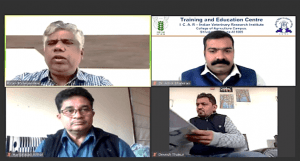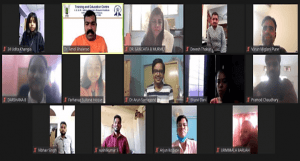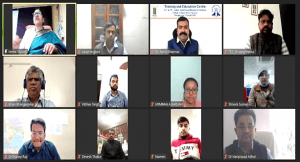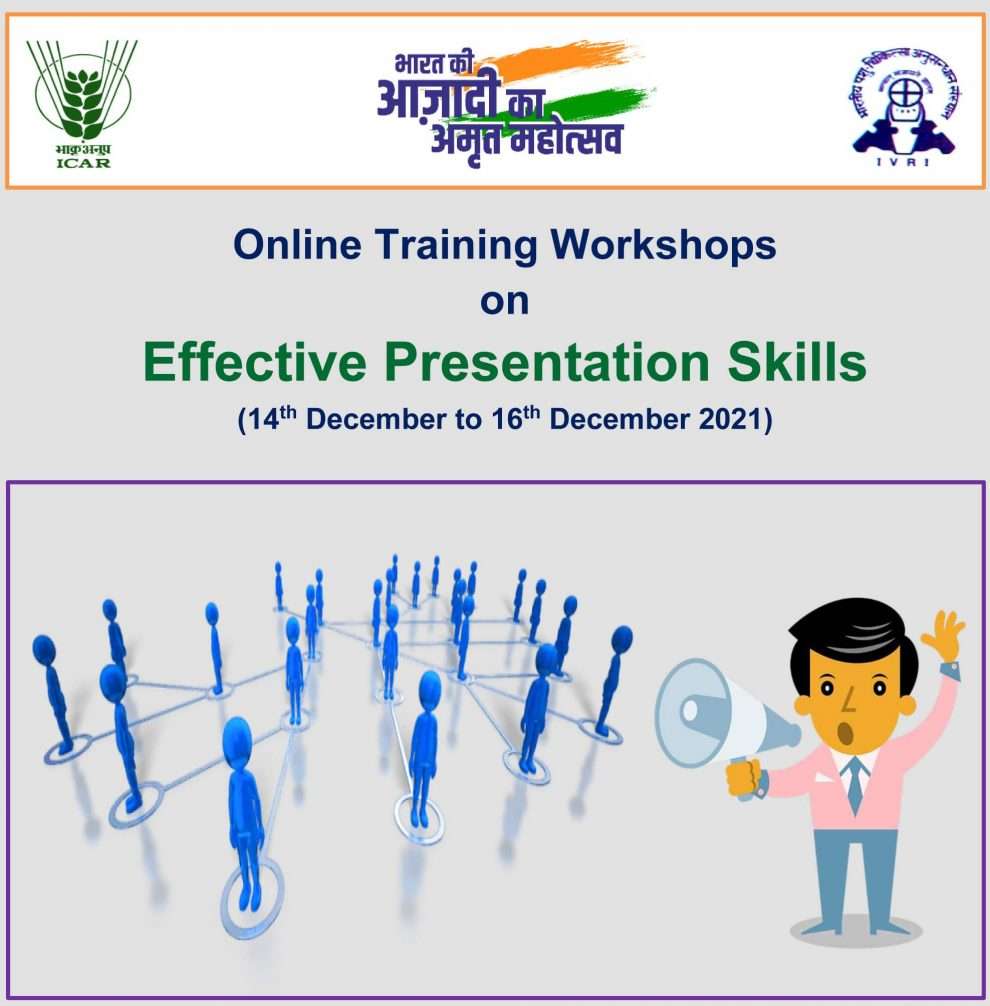Dr Devesh Thakur participated in the online training on ‘Effective Presentation Skills’ organised by ICAR-IVRI, Pune. What he learnt from the training is discussed in this meeting note.
CONTEXT
In India’s national agricultural education system, presentation skills have low priority. For example, students in the veterinary sciences undergraduate programme (which lasts five-and-a-half years) do not undergo training on how to improve their presentation skills. Students’ confidence is often diminished as a result of poor presentation capabilities. One of the reasons students are unable to communicate with teachers in the classroom is because of this. Furthermore, due to a lack of such abilities, speakers experience a huge amount of stress and discomfort during the preparation and delivery of presentations. Additionally, many post-graduate students and researchers give talks that contain far too many details, slides, and ambiguous images. As a result, we end up wasting much time collectively listening to poor presentations from different individuals.
Keeping this in mind the Training and Education Centre, ICAR-Indian Veterinary Research Institute organized a training event on ‘Effective Presentation Skills’ from 14 to 16 December 2021.The three-day training updated knowledge of participants on planning, content preparation, slide design, delivery, and also on how to handle questions during presentations. It also helped participants to overcome the usual anxiety and fear of presentation and public speaking. It was a paid soft skill training workshop wherein 34 participants participated via online mode. Trainees consisted of undergraduate students, post-graduate students, doctoral students, assistant professors, and associate professors from different disciplines hailing from 16 states of India.
 Dr Kiran Bhilengoonkar addressing trainees at the inaugural session of the training workshop.
Dr Kiran Bhilengoonkar addressing trainees at the inaugural session of the training workshop.
DESIGN OF VIRTUAL TRAINING
The three-day training programme had two daily sessions of two hours each – one in the forenoon (10AM-12 PM) and the other in the afternoon (3-5 PM). Dr Amol Bhalerao (Course Coordinator) and Dr Sangharatna Bahire (Course Co-coordinator) planned this training workshop to address the presentation skill requirements of young researchers in the agricultural sector. Dr Bhalerao was the resource person for all eight sessions of the training workshop, which included the following subjects: planning a presentation, content and design, breathing and body language, the art of introducing yourself, delivering a presentation, strategies to captivate the audience, tips for delivering thesis seminar/conference presentations, management of stage fear, dealing with audience questions, etc.
KEY EXCERPTS FROM THE SESSIONS
Planning a Presentation
A good presentation should be like a good book. An eloquent presenter, like a good book, should stir curiosity, arouse interest, provide new knowledge and understanding about the topic. It is important to do audience analysis by exploring the varied needs and expectations of the audience. A good presentation should be delivered keeping in mind the different learning styles of the varied audience. While listening to a presentation, the audience’s aim is to soak up information. This can happen only if there is extensive learning and communication styles. Broadly, people can be categorized into three types based on their learning preferences, preferred communication styles, and usage of nonverbal languages (Box 1). People come under the categories of visuals, aural and kinesics. So it is important that we use pictures, videos, and appropriate nonverbal language in our presentations.
Box 1. Different types of learners and their influence on presentations
|
Content and Design for a Presentation
The structure of a presentation should follow the 5 Ps approach, and the SMART criteria (see Box 2). For better presentations, san-serif fonts are suggested to be the best. Verdana, Tahoma, Georgia, Corbel and Calibri are the commonly used san-serif fonts for presentation. Serif fonts are useful, especially for printing maintaining uniformity of font including title fonts across all slides is important; one must avoid long sentences, long words and jargon unknown to listeners. Instead of passive voice use active voice in sentences. Next, avoid bright white backgrounds especially if presentation is on LED screens as they can cause retinal burnout. These practices – various font styles, vocabulary and proper use of fonts – can help to improve the design of a presentation.
| Box 2. Structure of a Presentation – the 5 P approach & SMART Criteria 5-P approach
SMART Criteria
|
Breathing and Body Language
Glossophobia, the fear of public speaking, is a common phobia and affects up to 75% of the population. Sweating, increased heart rate, dry mouth, difficulty in breathing, nausea, and headache are common physical symptoms. The release of neurochemical adrenaline in the body creates such symptoms in the body. This adrenaline surge can be managed by incorporating deep breathing exercises. Regular practice of such deep breathing exercises can help manage anxiety brought on by public speaking. Similarly, proper body language, such as upright body stance, eye movement, poised walk, and appropriate gestures can help make presentations more effective.
 A training workshop session.
A training workshop session.
The Art of Introducing Yourself
The power of a good introduction is immense, and introductions in personal and professional domains are often the beginning of something great. It is the social currency of our society and has tremendous impact, but strangely it is a topic that rarely gets its deserved attention. So the participants were divided into virtual groups where they were made to introduce themselves to others in the group (Box 3: Sample introduction). While introducing oneself, you should avoid a lengthy introduction and use a conversational tone. The best introductions need careful preparation.
This can be achieved gradually by adopting the following tips:
Write down your self-introduction; re-write and update it regularly; don’t send a CV to introduce yourself (one page will suffice); make an interesting introduction of yourself; people should remember your name; ensure that you are properly introduced by someone, if not then correct it; make direct eye contact with people and pay attention to your body language.; Stand straight but in a relaxed – not stiff – way; avoid folding your arms or holding your body in a defensive position; keep your introduction in context (don’t refer to your job position when you meet a parent at the playground); practice humility and keep initial conversations positive. You don’t want people to remember you as a complainer, criticizer, or arrogant person; also make sure you’re dressed and groomed well.
Box 3:Useful Phrases for Introducing Yourself
Sample Introduction Speech |
Delivering a Presentation
“Everything depends on the manner in which one communicates, not the matter,” states an old saying. A good delivery includes using a conversational tone, stressing key words, altering pitch, speaking rate, and inserting appropriate pauses. The audience’s attention should be drawn in right from the beginning of the presentation. This can be accomplished by beginning with an anecdote in a conversational tone, informing them what you’re about to say, presenting a story or a narrative, making a strong controversial statement, then clarifying it, utilising suitable quotes, or even by showing a visual or video (show a 30 second video). The conclusion of your discussion should include a vivid summary of your views, a call to action, or a poetical quotation.
Questioning the message
- What does my audience already know about this subject?
- How can I tap into the interest of listeners?
- What are the 3-5 key points I want my audience to remember?
- How can I make my message stick so as to enhance retention?
Questioning the visuals
- How can images support my core message?
- Are my images simple and of high quality?
- Is the written text unnecessary for my oral presentation?
- What can I do to minimize distractions and clutter in my slides?
Question the delivery
- Have I rehearsed enough?
- Do I have transitions built-in at appropriate points?
- How can I integrate pauses so as to maintain learner attention?
- What types of expressive behaviour can I use in my behaviour?
- Where can I incorporate active learning techniques into my presentation (role play, puzzle)?
Strategies to Captivate an Audience
Many scientific presentations are overburdened with facts and points. As the mind cannot recall so many things at once, such a conversation might become tedious. As a result, the audience’s focus is drawn away from the presentation. The persuasive model of Aristotle and Cicero’s De Oratore-5 Cannons of Rhetoric (Box 4), are effective strategies for a speaker to keep listeners’ attention for longer periods.
| Box 4. Models to captivate an audience Aristotle’s Persuasion Model: This model suggests that a good presentation should have three elements i.e., Ethos, Logos and Pathos to make it more captivating.
Ciero: De Oratore-5 Cannons of Rhetoric:
|
Other ways in which one can hold the interest of an audience from beginning till the end of a presentation are by:
- Asking thought-provoking questions;
- Sharing powerful/memorable stories;
- Making a point of staying animated;
- Providing valuable content;
- Keeping content fresh;
- Extending your usual vocal range;
- Experimenting with voice;
- Maintaining eye contact with all sections of the audience.
Presentations for Conferences/Thesis Seminar
KISS (Keep It Short and Simple) formulae and signposts phrases are known to make the presentations more effective and impactful in conferences and seminars.
While using the KISS formula, short sentences make effective presentations. Example: “The function of this department is the collection of accounts” (which is lengthy), instead simply say “The department collects accounts”. Similarly, keeping the language simple and clear, and avoiding jargon makes the explanation easier on the whole.
Example:
- Good: “We are at the threshold of a crisis which threatens to destabilize the status quo and users in the dawn of a new era of change.”
- Better: “We have a crisis at hand. This threatens to destabilize the status quo and usher in a new era.”
Signpost phrases help listeners to overview and learn the progress of delivery in a presentation (Table 1).
Table 1: Signpost phrases
| Section of Presentation | Signpost Language |
| I. Signpost for Overview (outline of presentation)
|
The subject/topic of my talk is … I’m going to talk about … My topic today is… My talk is concerned with …I have divided the presentation into three main parts: X, Y & Z In my presentation, I will focus on three major issues My talk will focus on three areas Firstly, I’ll give you an overview of… Secondly, I’ll highlight Finally, we’ll discuss briefly And lastly, I’ll offer some solutions. |
| II. Signpost to stress a main point | I would like to emphasize/stress/highlight the following points I would like to draw your attention to Let me point out that I’d like to focus your attention on I think you’ll be surprised to see that What’s really important here is Let’s look more closely at I would like you to concentrate on this It is important to notice that |
| III. Signposts during end of a presentation
|
This is the general picture for….. Let’s summarise the main issues……. Before we move on, let’s recap the main issues….. This brings us to the end of the first point That’s all I want to say about |
Dealing with Questions from the Audience
During presentations, responding to the questions posed and dealing with it tactically demands certain tips like:
- Listen carefully through the question;
- Decide whether you want to answer the question;
- If you decide you do, repeat, and if necessary, rephrase the question;
- Answer the question and only the question;
- Check that the answer was acceptable;
- Hinting well in advance about the questions;
- Admitting that you don’t know the answer;
- Throwing difficult questions out to the audience;
- Asking for clarification-reformulation for a difficult question;
- Expecting probable questions in a presentation.
Usually one can expect the following probable questions during presentations, such as What are the alternatives? What steps can we take? What could go wrong? How long does it take? How much does it cost? Who will be responsible? etc.
 Dr Hema Tripathi, the Chief Guest, interacting with the participants during the valedictory session.
Dr Hema Tripathi, the Chief Guest, interacting with the participants during the valedictory session.
KEY TAKEAWAYS FROM THE TRAINING
- Prepare your presentation based on visual, aural, and kinaesthetic types of learners.
- Use deep breathing exercises to manage the anxiety of public speaking.
- Use san-serif fonts for presentations and serif fonts for printing.
- Question your message, visuals, and delivery to improve your presentation.
- Use signpost phrases to clarify your speech during presentations.
- Apply KISS formulae in your presentations.
- Prepare your presentation based on the audience.
- Expect probable questions at a presentation.
CONCLUSION
As listeners, we often go through dull, irrelevant, or confusing presentations. It happens because most presenters are oblivious to the fact that effective presentations do not happen by chance, but rather they need much practice and effort. Presentations and public speaking help practically every aspect of our life and add to our overall success. They are part of classroom lectures, student thesis presentations, conference presentations, and even talking to farmers about the latest agricultural production practices. Though some people are naturally good at speaking, most of us can learn these skills. The objective of the training workshop was to make participants become aware and learn these skills. The ability to articulate effectively is a major skill. It’s time for educators, researchers, and extension personnel in the national agricultural education system to prioritize presentation and public speaking, in both theory and practice.
 Dr Devesh Thakur is an Assistant Professor in the Department of Veterinary & AH Extension Education, CSK Himachal Pradesh Agricultural University, Palampur (HP), India. He can be reached at Email: drdth4@gmail.com
Dr Devesh Thakur is an Assistant Professor in the Department of Veterinary & AH Extension Education, CSK Himachal Pradesh Agricultural University, Palampur (HP), India. He can be reached at Email: drdth4@gmail.com





Excellent account of online training on presentation skills. Very useful for effective communication which is often missing in most of the presentations we attend/hear. I feel it should be a part of regular training programs besides subject matter presentations. Congrats to Dr.Devesh Thakur for the write up.
Glad that Dr.Devesh Thakur shared his experiences of participating in an on line training programme on presentation skills. I understand it was a paid programme and I think interested people would have participated in the programme. I wonder how the skill of kinesics was organised in this on line training programme. It would have been better had the coordinators gave an opportunity for the participants to give a presentation on a chosen topic with the acquired skills for about five minutes. There was a scope for the coordinators to improve/correct the presentation skills of the participants.
There is no restriction on the extension faculty to impart presentation skills to the UG students. It is up to the faculty to impart presentation skills to the UG students as is being done in Veterinary college, Pondicherry.
I hope that the readers of this note will be benefited in improving their presentation skills. Thanks to Dr.Devesh Tahkur and AESA.